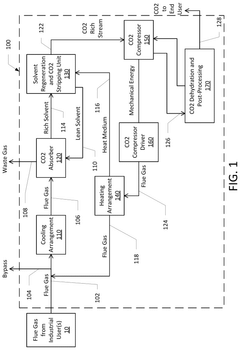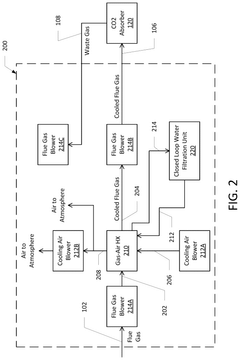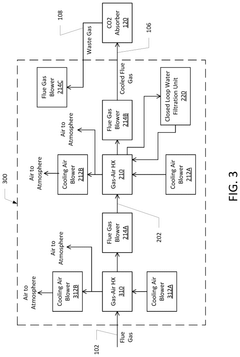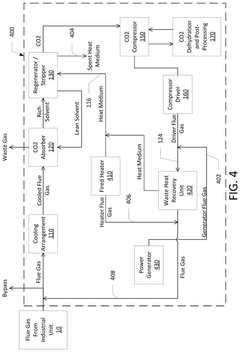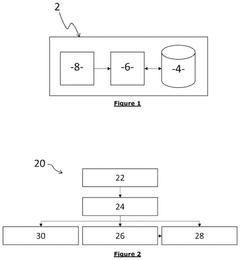The Role of Qualification in Carbon Capture Technology Implementation
OCT 27, 202510 MIN READ
Generate Your Research Report Instantly with AI Agent
Patsnap Eureka helps you evaluate technical feasibility & market potential.
Carbon Capture Technology Background and Objectives
Carbon capture technology has evolved significantly over the past several decades, transitioning from theoretical concepts to practical applications in various industrial settings. The technology's development can be traced back to the 1970s when concerns about climate change began to emerge in scientific communities. Since then, carbon capture has progressed through multiple generations of technological advancement, each addressing specific challenges related to efficiency, cost, and scalability.
The current trajectory of carbon capture technology is moving toward more integrated systems that can be deployed across diverse industrial sectors. This evolution is driven by the urgent need to reduce global carbon emissions in line with international climate agreements such as the Paris Accord, which aims to limit global warming to well below 2 degrees Celsius above pre-industrial levels.
Qualification processes play a critical role in this technological landscape. They serve as standardized mechanisms to validate the performance, safety, and reliability of carbon capture technologies before widespread implementation. These qualification frameworks ensure that technologies meet specific criteria for operational efficiency, environmental impact, and economic viability.
The primary objective of qualification in carbon capture technology implementation is to establish confidence among stakeholders, including industry leaders, policymakers, investors, and the public. By providing empirical evidence of a technology's capabilities and limitations, qualification processes help bridge the gap between laboratory innovation and commercial deployment.
Another key goal is to accelerate the adoption of promising carbon capture solutions by reducing perceived risks associated with new technologies. Rigorous qualification procedures can identify potential issues early in the development cycle, allowing for adjustments before significant investments are made in large-scale implementation.
Furthermore, qualification aims to create standardized metrics for evaluating different carbon capture technologies, enabling fair comparisons across various approaches such as post-combustion capture, pre-combustion capture, and direct air capture. These standardized assessments are essential for informed decision-making regarding technology selection and investment allocation.
Looking forward, the qualification landscape for carbon capture technologies is expected to evolve toward more comprehensive frameworks that consider not only technical performance but also broader impacts on energy systems, environmental justice, and sustainable development goals. This holistic approach to qualification will be crucial for ensuring that carbon capture technologies contribute meaningfully to climate mitigation efforts while avoiding unintended consequences in other domains.
The current trajectory of carbon capture technology is moving toward more integrated systems that can be deployed across diverse industrial sectors. This evolution is driven by the urgent need to reduce global carbon emissions in line with international climate agreements such as the Paris Accord, which aims to limit global warming to well below 2 degrees Celsius above pre-industrial levels.
Qualification processes play a critical role in this technological landscape. They serve as standardized mechanisms to validate the performance, safety, and reliability of carbon capture technologies before widespread implementation. These qualification frameworks ensure that technologies meet specific criteria for operational efficiency, environmental impact, and economic viability.
The primary objective of qualification in carbon capture technology implementation is to establish confidence among stakeholders, including industry leaders, policymakers, investors, and the public. By providing empirical evidence of a technology's capabilities and limitations, qualification processes help bridge the gap between laboratory innovation and commercial deployment.
Another key goal is to accelerate the adoption of promising carbon capture solutions by reducing perceived risks associated with new technologies. Rigorous qualification procedures can identify potential issues early in the development cycle, allowing for adjustments before significant investments are made in large-scale implementation.
Furthermore, qualification aims to create standardized metrics for evaluating different carbon capture technologies, enabling fair comparisons across various approaches such as post-combustion capture, pre-combustion capture, and direct air capture. These standardized assessments are essential for informed decision-making regarding technology selection and investment allocation.
Looking forward, the qualification landscape for carbon capture technologies is expected to evolve toward more comprehensive frameworks that consider not only technical performance but also broader impacts on energy systems, environmental justice, and sustainable development goals. This holistic approach to qualification will be crucial for ensuring that carbon capture technologies contribute meaningfully to climate mitigation efforts while avoiding unintended consequences in other domains.
Market Demand Analysis for Carbon Capture Solutions
The global carbon capture market is experiencing significant growth driven by increasing climate change concerns and stringent emission regulations. Current market assessments value the carbon capture, utilization, and storage (CCUS) market at approximately $2.5 billion in 2022, with projections indicating growth to reach $7.0 billion by 2030, representing a compound annual growth rate (CAGR) of 13.8%. This robust growth trajectory underscores the escalating demand for effective carbon capture solutions across various industries.
Industrial sectors, particularly power generation, cement production, steel manufacturing, and chemical processing, constitute the primary demand drivers for carbon capture technologies. These sectors collectively account for over 70% of global industrial carbon emissions, creating an urgent need for implementation-ready carbon capture solutions. The power generation sector alone represents nearly 40% of the current market demand, as coal and natural gas plants seek compliance with increasingly stringent emission standards.
Regional analysis reveals varying market dynamics, with North America and Europe leading adoption rates due to favorable regulatory frameworks and carbon pricing mechanisms. The Asia-Pacific region, particularly China and India, demonstrates the highest growth potential, driven by rapid industrialization coupled with emerging climate commitments. Middle Eastern countries are increasingly investing in carbon capture technologies to diversify their economies while maintaining value from hydrocarbon resources.
Qualification requirements have emerged as critical market factors influencing technology adoption. End-users increasingly demand technologies with demonstrated performance credentials, including third-party verification of capture efficiency, operational reliability under various conditions, and comprehensive lifecycle assessment. This qualification-driven market dynamic has created entry barriers for new technologies while accelerating demand for solutions with established performance records.
Market research indicates that cost remains the primary adoption barrier, with current carbon capture solutions adding between $40-100 per ton of CO₂ captured to operational expenses. This cost sensitivity has created market segmentation between high-performance premium solutions and more economical options with lower capture efficiencies. The qualification process directly impacts this cost-performance equation, with properly qualified technologies demonstrating better long-term value despite potentially higher initial investments.
Future market growth depends significantly on the evolution of qualification standards and certification processes. Industries are increasingly seeking standardized qualification frameworks that enable meaningful comparison between competing technologies. This trend is driving collaboration between industry associations, regulatory bodies, and technology developers to establish unified qualification protocols that can accelerate market adoption while ensuring performance reliability.
Industrial sectors, particularly power generation, cement production, steel manufacturing, and chemical processing, constitute the primary demand drivers for carbon capture technologies. These sectors collectively account for over 70% of global industrial carbon emissions, creating an urgent need for implementation-ready carbon capture solutions. The power generation sector alone represents nearly 40% of the current market demand, as coal and natural gas plants seek compliance with increasingly stringent emission standards.
Regional analysis reveals varying market dynamics, with North America and Europe leading adoption rates due to favorable regulatory frameworks and carbon pricing mechanisms. The Asia-Pacific region, particularly China and India, demonstrates the highest growth potential, driven by rapid industrialization coupled with emerging climate commitments. Middle Eastern countries are increasingly investing in carbon capture technologies to diversify their economies while maintaining value from hydrocarbon resources.
Qualification requirements have emerged as critical market factors influencing technology adoption. End-users increasingly demand technologies with demonstrated performance credentials, including third-party verification of capture efficiency, operational reliability under various conditions, and comprehensive lifecycle assessment. This qualification-driven market dynamic has created entry barriers for new technologies while accelerating demand for solutions with established performance records.
Market research indicates that cost remains the primary adoption barrier, with current carbon capture solutions adding between $40-100 per ton of CO₂ captured to operational expenses. This cost sensitivity has created market segmentation between high-performance premium solutions and more economical options with lower capture efficiencies. The qualification process directly impacts this cost-performance equation, with properly qualified technologies demonstrating better long-term value despite potentially higher initial investments.
Future market growth depends significantly on the evolution of qualification standards and certification processes. Industries are increasingly seeking standardized qualification frameworks that enable meaningful comparison between competing technologies. This trend is driving collaboration between industry associations, regulatory bodies, and technology developers to establish unified qualification protocols that can accelerate market adoption while ensuring performance reliability.
Current Status and Technical Challenges in Carbon Capture
Carbon capture technology has evolved significantly over the past two decades, with three primary approaches currently dominating the field: post-combustion capture, pre-combustion capture, and oxy-fuel combustion. Post-combustion technologies, particularly amine-based absorption systems, represent the most mature implementation with several commercial-scale projects operational globally. However, these systems face persistent challenges including high energy penalties, typically consuming 15-30% of power plant output, and significant capital costs ranging from $60-80 per ton of CO2 captured.
Pre-combustion capture, while theoretically more efficient, has seen limited deployment beyond demonstration projects due to the substantial modifications required to existing infrastructure. Oxy-fuel combustion technologies have shown promising capture rates exceeding 90% in pilot projects but struggle with the high energy demands of air separation units and material durability issues under extreme operating conditions.
Globally, carbon capture deployment remains well below the levels required to meet climate targets. The International Energy Agency estimates current global capture capacity at approximately 40 million tonnes annually, representing less than 0.1% of global emissions. This implementation gap stems from both technical and qualification-related challenges that impede widespread adoption.
Technical qualification standards for carbon capture technologies vary significantly across regions, creating regulatory uncertainty for developers and investors. In the United States, the EPA's Class VI well classification for CO2 storage has established rigorous monitoring requirements, while the EU's CCS Directive provides a comprehensive framework for risk assessment. However, many developing economies lack established qualification protocols entirely, hampering technology transfer and implementation.
Material qualification represents another significant challenge, particularly for novel solvents, sorbents, and membranes that promise improved capture efficiency. Accelerated aging tests often fail to accurately predict long-term performance under variable industrial conditions, leading to reliability concerns among potential adopters. The qualification of equipment and components for high-pressure CO2 service requires specialized testing protocols that remain inconsistently applied across the industry.
Integration challenges further complicate qualification efforts, as carbon capture systems must interface with existing industrial processes without compromising safety or operational reliability. The absence of standardized qualification methodologies for these integration points creates significant engineering uncertainties and increases project risk profiles. Additionally, the qualification of monitoring technologies for verifying capture rates and detecting potential leakage remains inconsistent, undermining confidence in environmental performance claims.
These qualification challenges collectively contribute to the "valley of death" phenomenon observed in carbon capture technology commercialization, where promising technologies struggle to progress from laboratory demonstration to industrial implementation despite their technical potential.
Pre-combustion capture, while theoretically more efficient, has seen limited deployment beyond demonstration projects due to the substantial modifications required to existing infrastructure. Oxy-fuel combustion technologies have shown promising capture rates exceeding 90% in pilot projects but struggle with the high energy demands of air separation units and material durability issues under extreme operating conditions.
Globally, carbon capture deployment remains well below the levels required to meet climate targets. The International Energy Agency estimates current global capture capacity at approximately 40 million tonnes annually, representing less than 0.1% of global emissions. This implementation gap stems from both technical and qualification-related challenges that impede widespread adoption.
Technical qualification standards for carbon capture technologies vary significantly across regions, creating regulatory uncertainty for developers and investors. In the United States, the EPA's Class VI well classification for CO2 storage has established rigorous monitoring requirements, while the EU's CCS Directive provides a comprehensive framework for risk assessment. However, many developing economies lack established qualification protocols entirely, hampering technology transfer and implementation.
Material qualification represents another significant challenge, particularly for novel solvents, sorbents, and membranes that promise improved capture efficiency. Accelerated aging tests often fail to accurately predict long-term performance under variable industrial conditions, leading to reliability concerns among potential adopters. The qualification of equipment and components for high-pressure CO2 service requires specialized testing protocols that remain inconsistently applied across the industry.
Integration challenges further complicate qualification efforts, as carbon capture systems must interface with existing industrial processes without compromising safety or operational reliability. The absence of standardized qualification methodologies for these integration points creates significant engineering uncertainties and increases project risk profiles. Additionally, the qualification of monitoring technologies for verifying capture rates and detecting potential leakage remains inconsistent, undermining confidence in environmental performance claims.
These qualification challenges collectively contribute to the "valley of death" phenomenon observed in carbon capture technology commercialization, where promising technologies struggle to progress from laboratory demonstration to industrial implementation despite their technical potential.
Current Qualification Frameworks for Carbon Capture Implementation
01 Carbon Capture Qualification Methods and Standards
Various methods and standards are used to qualify carbon capture technologies, ensuring they meet specific performance criteria. These qualification processes involve testing protocols, certification standards, and performance metrics that evaluate the efficiency, reliability, and environmental impact of carbon capture systems. Qualification methods typically include laboratory testing, pilot-scale demonstrations, and field validations to verify that the technology can achieve the claimed carbon capture rates under real-world conditions.- Direct Air Capture (DAC) Systems: Direct Air Capture systems are designed to extract carbon dioxide directly from the atmosphere. These technologies use various sorbents and mechanical systems to capture CO2 from ambient air, which can then be stored or utilized. DAC systems typically undergo qualification processes that evaluate their efficiency, energy consumption, and scalability. The qualification includes testing under different environmental conditions to ensure consistent performance and reliability.
- Post-Combustion Carbon Capture Methods: Post-combustion carbon capture technologies focus on removing CO2 from flue gases after the combustion process. These methods typically employ chemical solvents, membranes, or solid sorbents to separate CO2 from other exhaust gases. Qualification protocols for these technologies assess parameters such as capture efficiency, solvent degradation, energy penalties, and operational stability under industrial conditions. The qualification process often includes pilot-scale testing before full commercial implementation.
- Monitoring and Verification Systems: Carbon capture technology qualification requires robust monitoring and verification systems to ensure the effectiveness and reliability of the capture process. These systems include sensors, data analytics platforms, and imaging technologies that track CO2 capture rates, purity levels, and storage integrity. Qualification procedures evaluate the accuracy, precision, and durability of these monitoring systems under various operational conditions to ensure compliance with regulatory standards and performance metrics.
- Geological Storage Qualification: Geological storage is a critical component of carbon capture technology qualification, involving the assessment of subsurface formations for long-term CO2 storage. Qualification processes evaluate reservoir characteristics, caprock integrity, potential leakage pathways, and geochemical interactions. These assessments typically include geological surveys, modeling simulations, and injection tests to verify storage capacity and containment security. The qualification also addresses monitoring requirements for detecting potential migration or leakage of stored CO2.
- Integration and System Performance Standards: Carbon capture technology qualification includes standards for system integration and overall performance assessment. These standards evaluate how capture technologies integrate with existing industrial processes or power generation systems. Qualification procedures assess energy efficiency, operational flexibility, and economic viability across different scales and applications. The standards also consider factors such as technology readiness levels, scalability potential, and compatibility with various industrial sectors to ensure practical implementation and commercial viability.
02 Direct Air Capture (DAC) Technology Validation
Direct Air Capture technologies require specific qualification procedures to verify their ability to extract CO2 directly from ambient air. The qualification process for DAC systems evaluates factors such as sorbent performance, energy efficiency, capture capacity, and operational stability over time. These technologies must demonstrate consistent performance across varying environmental conditions, including different humidity levels and temperatures, to receive proper qualification and certification for commercial deployment.Expand Specific Solutions03 Industrial Carbon Capture System Certification
Certification processes for industrial carbon capture systems focus on evaluating their integration with existing industrial processes, such as power generation, cement production, or steel manufacturing. Qualification procedures assess the capture efficiency, energy penalties, operational reliability, and economic viability of these systems. The certification also examines how effectively the technology can be scaled and adapted to different industrial settings while maintaining consistent performance in removing carbon dioxide from industrial emissions.Expand Specific Solutions04 Monitoring and Verification Technologies for Carbon Capture
Advanced monitoring and verification technologies are essential components of carbon capture qualification systems. These technologies include sensors, imaging systems, and data analytics platforms that continuously track the performance of carbon capture installations. Qualification standards for these monitoring systems evaluate their accuracy, reliability, and ability to detect variations in capture efficiency or potential leakage. Proper monitoring and verification are critical for regulatory compliance, carbon credit certification, and maintaining public trust in carbon capture projects.Expand Specific Solutions05 Carbon Storage and Utilization Qualification Frameworks
Qualification frameworks for carbon storage and utilization assess the long-term viability and safety of captured carbon dioxide. These frameworks evaluate geological storage sites, enhanced oil recovery applications, and carbon utilization pathways such as conversion to fuels or materials. The qualification process examines factors including storage capacity, containment security, monitoring capabilities, and potential environmental impacts. Comprehensive risk assessment methodologies are applied to ensure that stored or utilized carbon remains permanently sequestered from the atmosphere.Expand Specific Solutions
Key Industry Players in Carbon Capture Sector
Carbon capture technology implementation is currently in a transitional phase, moving from early adoption to commercial scaling. The global carbon capture market is projected to reach $7-10 billion by 2030, growing at 20-25% annually as climate policies strengthen. Technologically, maturity varies significantly across capture methods. Leading players demonstrate different specialization levels: Chinese entities like Huaneng Clean Energy Research Institute and CNPC focus on large-scale demonstration projects and integration with existing energy infrastructure; Western corporations such as IBM, ExxonMobil, and Schlumberger emphasize technological innovation and proprietary solutions; while academic institutions (Dalian University of Technology, Ohio State, Columbia) drive fundamental research. 8 Rivers Capital and Saudi Aramco are advancing commercial-scale implementations, indicating the technology's progression toward wider deployment despite remaining cost and efficiency challenges.
Huaneng Clean Energy Research Institute
Technical Solution: Huaneng Clean Energy Research Institute has developed a comprehensive qualification framework for carbon capture technologies, particularly focused on post-combustion capture at coal-fired power plants. Their approach includes a multi-stage qualification process starting with laboratory testing, followed by pilot-scale demonstrations, and culminating in commercial-scale implementation. The institute has successfully implemented China's first full-chain carbon capture, utilization, and storage (CCUS) demonstration project at the Gaobeidian power plant in Beijing, capturing over 120,000 tons of CO2 annually. Their qualification methodology emphasizes technical performance metrics including capture efficiency (achieving >90%), energy penalties (<30% additional energy consumption), and solvent degradation rates, while also incorporating economic feasibility assessments through detailed techno-economic analysis frameworks that account for China's specific market conditions.
Strengths: Strong integration with existing coal power infrastructure; extensive practical experience in scaling from pilot to commercial implementation; comprehensive qualification framework tailored to China's energy landscape. Weaknesses: Primarily focused on post-combustion technologies rather than a diverse portfolio; qualification standards may be less applicable to international contexts with different regulatory environments.
China National Petroleum Corporation
Technical Solution: China National Petroleum Corporation (CNPC) has established a rigorous qualification system for carbon capture technologies specifically tailored for integration with enhanced oil recovery (EOR) operations. Their qualification process evaluates carbon capture technologies based on compatibility with existing petroleum extraction infrastructure, focusing on parameters such as CO2 purity requirements (>95%), compression capabilities, and transport specifications. CNPC has implemented this qualification framework at the Jilin Oil Field CCUS project, China's first full-chain CCUS-EOR project, which has sequestered over 1.1 million tons of CO2 while increasing oil production by 10-15%. Their qualification methodology incorporates geological assessment protocols to evaluate storage capacity, injectivity, and containment security, alongside monitoring, reporting, and verification (MRV) systems that comply with both national standards and international best practices. The company has developed specialized qualification criteria for different capture technologies (chemical absorption, physical absorption, membrane separation) based on their applicability to various emission sources within petroleum operations.
Strengths: Seamless integration of carbon capture qualification with EOR operations creating economic incentives; well-established geological assessment protocols; practical experience with large-scale implementation. Weaknesses: Qualification framework primarily oriented toward oil industry applications rather than broader industrial sectors; potential conflict between carbon reduction goals and continued fossil fuel production.
Critical Patents and Technical Literature Review
Devices, systems, facilities and processes for carbon capture optimization in industrial facilities
PatentPendingUS20250186936A1
Innovation
- The implementation of a carbon capture system that uses a gas-to-air heat exchanger to cool the flue gas stream before it enters the CO2 absorber, reducing the need for evaporative cooling water systems and minimizing water consumption.
Method for assessing carbon capture of an area of interest
PatentPendingUS20240320835A1
Innovation
- A method utilizing image analysis algorithms on top-down images to determine environmental data and compute a carbon capture indicator, which includes associating primary producers with expected net primary productivity and incorporating habitat features, allowing for remote monitoring and prediction of carbon capture potential.
Regulatory and Policy Landscape for Carbon Capture Technologies
The regulatory and policy landscape for carbon capture technologies has evolved significantly over the past decade, creating a complex framework that directly impacts qualification requirements and implementation strategies. National and international climate agreements, particularly the Paris Agreement, have established ambitious carbon reduction targets that have catalyzed policy development supporting carbon capture deployment. These frameworks often include specific qualification standards that technologies must meet to receive governmental support or market access.
In the United States, the 45Q tax credit has emerged as a cornerstone policy, offering substantial financial incentives for qualified carbon capture projects. Recent enhancements to this program have expanded eligibility criteria while simultaneously raising technical qualification standards. Similarly, the European Union's Innovation Fund and Emissions Trading System provide regulatory mechanisms that incorporate increasingly stringent qualification requirements for carbon capture technologies seeking support.
Regulatory frameworks typically establish multi-tiered qualification systems that assess technologies based on capture efficiency, energy penalties, environmental impact, and operational reliability. These qualification standards often vary by sector, with power generation, industrial applications, and direct air capture facing different regulatory requirements. This sectoral approach recognizes the varying technical challenges and implementation contexts across industries.
Permitting processes represent another critical regulatory dimension, with qualification requirements embedded throughout environmental impact assessments, safety certifications, and operational licensing. The complexity of these processes has prompted several jurisdictions to develop streamlined regulatory pathways for qualified carbon capture technologies, though navigating these frameworks remains challenging for many implementers.
Policy incentives increasingly incorporate performance-based qualification metrics that reward higher capture rates and more efficient operations. This shift from technology-specific to performance-based qualification standards has created more flexible implementation pathways while maintaining rigorous environmental outcomes. However, this approach requires sophisticated monitoring, reporting, and verification systems to ensure compliance.
International harmonization of qualification standards remains limited, creating potential barriers for global technology deployment. Efforts by organizations such as the International Organization for Standardization (ISO) and the Carbon Capture and Storage Association are working to develop consistent qualification frameworks that could facilitate cross-border implementation and technology transfer, though significant regional variations persist.
In the United States, the 45Q tax credit has emerged as a cornerstone policy, offering substantial financial incentives for qualified carbon capture projects. Recent enhancements to this program have expanded eligibility criteria while simultaneously raising technical qualification standards. Similarly, the European Union's Innovation Fund and Emissions Trading System provide regulatory mechanisms that incorporate increasingly stringent qualification requirements for carbon capture technologies seeking support.
Regulatory frameworks typically establish multi-tiered qualification systems that assess technologies based on capture efficiency, energy penalties, environmental impact, and operational reliability. These qualification standards often vary by sector, with power generation, industrial applications, and direct air capture facing different regulatory requirements. This sectoral approach recognizes the varying technical challenges and implementation contexts across industries.
Permitting processes represent another critical regulatory dimension, with qualification requirements embedded throughout environmental impact assessments, safety certifications, and operational licensing. The complexity of these processes has prompted several jurisdictions to develop streamlined regulatory pathways for qualified carbon capture technologies, though navigating these frameworks remains challenging for many implementers.
Policy incentives increasingly incorporate performance-based qualification metrics that reward higher capture rates and more efficient operations. This shift from technology-specific to performance-based qualification standards has created more flexible implementation pathways while maintaining rigorous environmental outcomes. However, this approach requires sophisticated monitoring, reporting, and verification systems to ensure compliance.
International harmonization of qualification standards remains limited, creating potential barriers for global technology deployment. Efforts by organizations such as the International Organization for Standardization (ISO) and the Carbon Capture and Storage Association are working to develop consistent qualification frameworks that could facilitate cross-border implementation and technology transfer, though significant regional variations persist.
Environmental Impact Assessment and Sustainability Metrics
Carbon capture technologies must be evaluated not only for their technical efficacy but also for their broader environmental impacts and sustainability credentials. A comprehensive environmental impact assessment (EIA) framework specifically tailored for carbon capture technologies is essential to ensure that these solutions do not create more problems than they solve.
The life cycle assessment (LCA) of carbon capture technologies reveals complex environmental trade-offs. While these technologies reduce CO2 emissions, they may increase other environmental burdens such as water consumption, land use, and energy requirements. For instance, amine-based capture systems can reduce carbon emissions by 80-90% but may increase water usage by 25-40% and energy consumption by 20-30% compared to unabated power plants.
Qualification protocols must incorporate sustainability metrics that extend beyond simple carbon accounting. These metrics should include water footprint (measuring both consumption and pollution), energy return on investment (EROI), land use efficiency, and potential for ecological disruption. The development of standardized sustainability indicators specific to carbon capture technologies would enable more meaningful comparisons between different technological approaches.
The environmental justice implications of carbon capture deployment must also be considered within qualification frameworks. Historical patterns show that industrial facilities, including those with pollution control technologies, are disproportionately located in disadvantaged communities. Qualification standards should therefore include social impact assessments that evaluate potential effects on local communities, particularly vulnerable populations.
Biodiversity impacts represent another critical dimension for assessment. Carbon capture facilities, especially those utilizing biological sequestration methods, can significantly alter local ecosystems. Qualification protocols should evaluate potential habitat disruption, changes to local species composition, and long-term ecological resilience.
Emerging research suggests that a systems-thinking approach to environmental assessment is particularly valuable for carbon capture technologies. This approach recognizes the interconnected nature of environmental systems and evaluates how interventions in one area (carbon emissions) affect other environmental parameters. Qualification frameworks that incorporate this systems perspective are more likely to identify unintended consequences before deployment at scale.
The development of dynamic sustainability metrics that evolve with technological maturity represents a promising direction. Early-stage technologies might be evaluated on different criteria than mature systems, with qualification thresholds that become more stringent as technologies advance through development stages.
The life cycle assessment (LCA) of carbon capture technologies reveals complex environmental trade-offs. While these technologies reduce CO2 emissions, they may increase other environmental burdens such as water consumption, land use, and energy requirements. For instance, amine-based capture systems can reduce carbon emissions by 80-90% but may increase water usage by 25-40% and energy consumption by 20-30% compared to unabated power plants.
Qualification protocols must incorporate sustainability metrics that extend beyond simple carbon accounting. These metrics should include water footprint (measuring both consumption and pollution), energy return on investment (EROI), land use efficiency, and potential for ecological disruption. The development of standardized sustainability indicators specific to carbon capture technologies would enable more meaningful comparisons between different technological approaches.
The environmental justice implications of carbon capture deployment must also be considered within qualification frameworks. Historical patterns show that industrial facilities, including those with pollution control technologies, are disproportionately located in disadvantaged communities. Qualification standards should therefore include social impact assessments that evaluate potential effects on local communities, particularly vulnerable populations.
Biodiversity impacts represent another critical dimension for assessment. Carbon capture facilities, especially those utilizing biological sequestration methods, can significantly alter local ecosystems. Qualification protocols should evaluate potential habitat disruption, changes to local species composition, and long-term ecological resilience.
Emerging research suggests that a systems-thinking approach to environmental assessment is particularly valuable for carbon capture technologies. This approach recognizes the interconnected nature of environmental systems and evaluates how interventions in one area (carbon emissions) affect other environmental parameters. Qualification frameworks that incorporate this systems perspective are more likely to identify unintended consequences before deployment at scale.
The development of dynamic sustainability metrics that evolve with technological maturity represents a promising direction. Early-stage technologies might be evaluated on different criteria than mature systems, with qualification thresholds that become more stringent as technologies advance through development stages.
Unlock deeper insights with Patsnap Eureka Quick Research — get a full tech report to explore trends and direct your research. Try now!
Generate Your Research Report Instantly with AI Agent
Supercharge your innovation with Patsnap Eureka AI Agent Platform!
